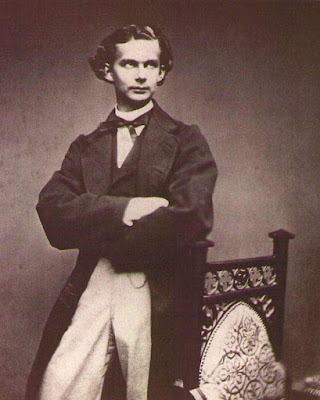(Article, ‘Über Staat und
Religion,’ first published in The Cambridge Wagner
Encyclopedia, ed. Nicholas Vazsonyi
(Cambridge: Cambridge University Press, 2013))
 |
| Ludwig II, 1864 |
The
strategy resembles that of the contemporary Mein
Leben. Not least on account of the works’ common – royal – addressee,
Wagner presents himself as a revolutionary primarily for the sake of (his) art.
Such an attitude would eventually also characterize the Bayreuth Circle; some may even have believed that.
Nevertheless, the strong relationship between politics
and aesthetics endures. Wagner
claims political interest to be a reflection and product of artistic concerns;
ensuing discussion of his aesthetics immediately renders the relationship
dialectical, just as when he had tilted the scales towards politics earlier.
Moreover, Wagner does not disavow but revisits and sometimes reiterates certain
key socialist themes from Dresden
and Zurich, for instance abolition of the state and overcoming the
constrictions of modern labor. He distances himself from a form of “newer socialist”
distribution to which he had never subscribed in the first place (SSD 8:5). The word is killed that the
spirit might live.
Schopenhauer is the principal agent of
intellectual as opposed to circumstantial transformation, though the
distinction is not always clear. The blind striving of Schopenhauer’s Will
paints humanity less optimistically: egoistic individualism requires societal
stability (Stabilität), which
individuals have for their own protection invested in the state. Schopenhauer’s
Wahn (illusion) bids individual hopes
express themselves in patriotism, embodied in the monarch. (This need not
entail a nation-state; Bavarian particularism would be just as well served
here.) Monarchical independence furthers a number of related purposes,
including restraint of the base commercial imperatives of the press – Wagner
would soon be in need of that – and inspiration to redeem life by rising above
it. Monarchy appears a political and
metaphysical necessity. No revolution
– Wagner cannot quite bring himself to use the word – has ever failed to result
in restoration of that ideal representation of the state.
In
a new twist upon his idea of republican monarchy as adumbrated in the 1849
speech to the Dresden Vaterlandsverein, the king, as self-sacrificing “saint” –
in the vein of Schopenhauerian renunciation – dispenses “grace” (Gnade), rising above any particular
interest, his own or others’. State power is mitigated and ultimately negated
by two higher, ascending forms of Wahn: religion
(avowedly not theology: Feuerbach’s distinction still holds) and
art. Art’s superiority over religion as announced in the opening of Religion
und Kunst – no one believes art must be “true” – is foreshadowed.
Reading between the lines, artistic patronage would seem a good practical
example of how Wahn might be
harnessed, Hans Sachs-like, to
public good as well as princely salvation. Ludwig’s response seems to have been
of that ilk.